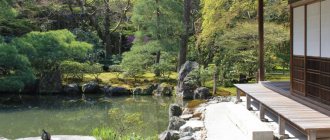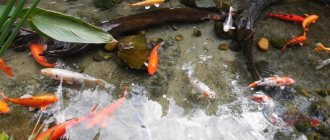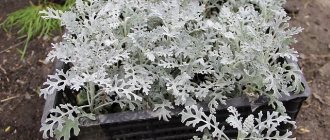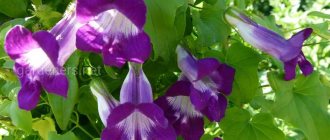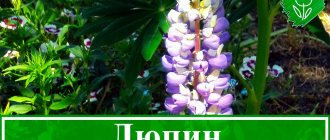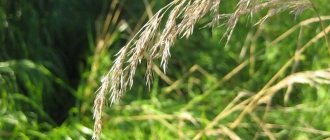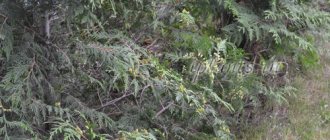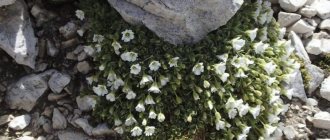A pond in a dacha is not only beautiful. It makes the air more humid and cooler on hot days. And if you have fish in the pond, then there will be even more benefits from it. Even if you don't eat fish, you can admire how it behaves in its usual environment. What kind of fish can you keep in a pond at your dacha? How and what to feed them? Where to buy fry and how to provide the fish with optimal wintering? You will find answers to these questions in my material. But first, I’ll tell you how to make a reservoir suitable for keeping fish on your property.
How to breed fish in the country - tips for beginners
Selecting a location
When creating a fish pond, its correct location is important. The lowest, sunny place on your site is well suited for this purpose.
There should be no trees or shrubs nearby - their roots can damage the bowl of the reservoir. It is also recommended to locate the pond away from buildings to prevent their shrinkage.
Tench
If carp and crucian carp can be placed in the same reservoir, then their proximity to tench is not recommended. Tench is a fish that does not require complex care and monitoring of water quality. The average weight of tench is 0.2-0.8 kg.
This is a bottom-dwelling fish that can survive even in unfavorable conditions, so growing it in your own pond is not at all difficult. Females become sexually mature by the fourth year of life, males by the second.
Tench is a fertile fish; in order to fertilize the eggs of one female, at least two males are needed. Tench spawning occurs from May to August.
- A DIY mailbox is a beautiful decoration and a useful addition to a suburban area
A house for children is a place where a fairy tale becomes reality, we create it ourselves
Bridges for a dacha - a picturesque element of the landscape in a suburban area
For the growth of large individuals, it is necessary to create conditions that the tench likes, despite its vitality. Tench is thermophilic and prefers to feed on vegetation and crustaceans. If there is little vegetation in the pond, it is recommended to fertilize the pond.
Dimensions
The optimal size of a reservoir for fish farming is 15-50 sq.m, the depth should be at least 1 meter and no more than 3, and it is preferable that the bottom have differences in relief. Thanks to the differences, the water will warm up well in the shallowest places, and fish will be able to winter in the deepest ones.
Calculation of the volume of the future pond directly depends on the planned species and number of fish that will inhabit it. One fish measuring 10 cm on average needs 50 liters of water.
Food for aquatic inhabitants
Artificial fish breeding can only be successful if there is a responsible attitude to the issue of feeding them. The most unpretentious species is carp, which eats almost everything. It can be fed with feed for pigs or poultry, and the loose powder should be thoroughly mixed with water to form a porridge, and then sent to a pond.
Other breeds prefer a pre-steamed and swollen mixture of grains and legumes. The volume of this food should not exceed 3-6% of the weight of the fish itself. It is recommended to feed 1-2 times a day in a certain place in the reservoir at the same time. For convenience, a specially equipped table-pallet is used. This convenience lies in the fact that it can be lowered to the bottom without any problems, and then taken out from there with the same ease. With the help of such a design, it is easy to track how much food has been eaten and whether there are any pieces left that will pollute the water.
It is very interesting to observe how the ringing of a small bell gradually creates a conditioned reflex in the fish and they gather in a flock to feast on the food brought by the owner.
Undoubtedly, breeding fish in an artificial reservoir is not an easy task , because all the conditions must be met to keep them as comfortable as possible. In this case, the fish will live a long time and delight their owners.
Water supply and drainage
You should immediately think about how and from what source the water will come. This will decide the appearance and design of the bowl. You can supply water along the bottom of the reservoir. Then the pipe needs to be dug in and brought out at the bottom of the reservoir. Water can also come from an artificially made stream or water cascade.
To fill the pond, both tap water and water from an artificial well or collected rainwater are suitable. After filling the bowl, wait 3-4 days, wait until the water warms up and only then introduce the fish, this will create more comfortable conditions for it.
Water can be drained into a drainage ditch or a nearby stream. For this purpose, a pipe is installed at the bottom. You can also pump out water with a pump and use it for irrigation.
What kind of fish are raised in ponds?
Before starting your own business in this area, it is worth finding out what kind of fish is best to breed and what type will be most profitable. As a rule, many entrepreneurs choose two options: carp or trout. It is this fish that is in greatest consumer demand.
Without a doubt, growing carp is much easier and less troublesome. For this purpose, less money will be required than for fattening trout. From the above, the following conclusion suggests itself: the most profitable option in all respects is growing carp.
Construction
After calculating the required volume of the pond, a multi-stage pit should be dug. The steps should be 20-30 cm wide, the number should be from 2 to 4. The soil in the pit should be carefully leveled and compacted. Afterwards, the soil should be sprinkled with sand (15-20 cm) and crushed stone (about 5 cm), and 10-15 cm of reinforced concrete should be poured on top. Afterwards the waterproofing is laid out. The banks can be decorated with large stones.
Building a pond of such complexity is a difficult and costly task. But this design of the reservoir is the most convenient and durable. The bowl of the pond will be protected from damage, and the steps made will serve not only for placing plants, but will also be convenient for descending into the bowl and washing it.
A more budget-friendly option would be to cover the earthen bottom with thick plastic film. The method is very unreliable, so a combination of methods is often done - the walls and bottom are cemented and a layer of film is laid on top.
If you plan to winter fish in the same reservoir, it is recommended to make a “wintering hole” in it. Most often, this is simply a barrel dug into the bottom of the pond without a lid, in which the water will not freeze in winter.
How to sell products
If your products are of acceptable quality, then you will not have problems selling them. In every region of our country, all conditions have been created for the effective marketing of live fish. Let's consider several of the most popular options for selling products:
- Through the fish departments of large supermarkets.
- In the markets.
- Through networks of specialized stores.
All that is required of you is to enter into an agreement with the store management for the supply of food products.
Design and creation of an ecosystem
Moisture-loving sedge, hosta and ferns will help decorate the area around the pond. Calamus is a good choice for planting on the first underwater steps of a pond. For a large reservoir, marsh calamus, reaching 1 m in height, is preferable, and for a small reservoir, grass calamus, 40 cm high, is preferable. Pots with calligraphy can be placed along the steps. You should not plant it loosely - it will quickly grow throughout the entire water surface.
Since an artificial pond is a closed system, it cannot do without aquatic plants and algae. It simply requires plants that produce oxygen. The most active plants in this regard are hornwort, buttercup, marsh grass and water moss. Plant them in pots and place them at the bottom of the pond.
To prevent the pond from being polluted by excess algae and to protect it from overheating, deep-sea plants such as water lilies, brassicas and egg capsules will help. Their root system is located at depth, since the upper part floats on the surface.
New Year's crafts from pine cones: decor ideas from pine cones for the New YearDecorative elements made of stone as an integral part of landscape design
Smartphone case: overview of the main types
Also, floating non-rooting plants - bagel, watercolor, azolla - will save the water from overheating and blooming. The number of these plants needs to be regulated independently, as they can quickly cover the entire surface of the reservoir.
Many experts advise that when using tap or artesian water to fill a reservoir, pour 2-3 buckets of river water into it. This will help small algae multiply in it and create a familiar ecosystem for the fish.
It is imperative to constantly monitor the acid-base balance of water. The optimal value is 7-8 pH. When this indicator decreases to 5, limestone or soda should be added to the water until the desired pH values are obtained.
Features of fish farming business
If you are not specialists in the field of fish farming, then it is best to start such a business with a small pond with carp. The optimal water temperature for carp is 20-27°C with an oxygen content of 5-7 mg/l. If the temperature drops to 14°C or lower, the fish eats less and does not gain weight. At a water temperature of 7°C, carp stop feeding and lose activity. Under favorable conditions, carp weight gain can reach 7-8 grams per day. Sexual maturity occurs at 3-5 years of age. Carp spawn in the spring, laying eggs on vegetation in shallow areas of the reservoir. The fry hatch on average after five days.
The production cycle of fish farming lasts two years. By this age, the weight of one carp is 300-800 grams. And by the age of three, the weight of a male can reach 1-2 kg. The weight gain of carp is greatly influenced by the quality of water, feed, living conditions, and climate. It is most profitable to breed carp and other types of fish in the southern regions of our country.
Fish farming is a profitable business, with an average profitability of 15%. However, it requires considerable investment. Most of the funds will be used to equip the reservoir (from 3 million rubles in the best case), purchase food (4 kg of food is required to obtain a carp weight gain of 1 kg) and fry.
Of course, you can also raise fish on natural food - the so-called extensive method. But in this case, no more than 0.3-0.4 tons of fish can be obtained from 1 hectare, while with additional feeding the productivity can be up to 1.2 tons per 1 hectare per year. When using a high level of intensive cultivation in cages, which involves frequent feeding of fish, high stocking density and the creation of additional conditions in reservoirs for productive breeding (constant aeration and liming of the reservoir), it is possible to obtain up to 5-6 tons of fish products per hectare.
However, in this case, feed costs will increase even more. With a high-intensity growing method, high-protein nutritious feed is used with a protein content of at least 26-28% and fat - 6-7%. The average price of carp food is 8-9 rubles per kilogram. High-protein nutritious food will cost twenty percent more.
To grow trout, experts advise using European-made feed at a price of about 0.9-1 euro per kilogram. Although such food is also produced in our country, so far only by a couple of enterprises. However, cheap feed has virtually no effect on the taste of trout meat, but with such nutrition it has a light color. Domestic consumers are accustomed to the fact that trout meat is red, and special feed additives obtained from krill give it such a bright shade.
It would seem that the high cost of trout food makes its breeding economically unprofitable. However, the high cost of feed is compensated by its lower consumption and the high cost of meat. If for 1 kg of weight gain in carp you need to spend about 4 kg of feed, then in the case of trout the consumption will be only 1 kg per 1 kg of weight gain. Ultimately, the costs of growing one kilogram of carp and trout are approximately equal - about 35-38 and 40-45 rubles per kilogram in the first and second cases, respectively.
Purchasing fry
Buying fry is not difficult now. There are many companies engaged in breeding fish for stocking water bodies.
Buying a tench fry measuring 7-14 cm will cost about 70 rubles, crucian carp (35-45 cm) - 200 rubles apiece, crucian carp up to 40 cm in size will cost an average of 100 rubles.
Koi carp
Ornamental carp is suitable for growing in ponds. A lover of deep reservoirs, but will not hide in shallow water.
Fish of this breed have a variety of colors, grow large, are not afraid of people, so if they do not hide in a shallow body of water, you can safely admire them.
Winter period
Intensive, proper nutrition will help prepare the fish for the winter. Healthy, strong fish can withstand cold weather more easily.
Wintering of fish is possible only in reservoirs that are more than 1.5 m deep and have a bottom wintering pit.
Regularly make a hole in the ice crust formed on the surface of the pond. Do not completely remove ice from the surface - this can lead to supercooling of the water.
You can pump out some of the water from a frozen pond with a pump - this will increase the air gap, enriching the water with oxygen. You can also use an aerator in winter.
Now you know how to breed fish in a pond. How profitable this activity is is up to you to decide. However, one cannot but agree that a home pond with real fish can be an excellent place for home relaxation and simply a bright design solution for decorating a summer cottage.
Carp
Carp is considered unpretentious for cultivation, therefore it occupies a leading position in choosing the type of fish for the pond. For convenience, it is recommended to stock already grown one-year-old individuals; if you stock young animals, you will have to provide it with additional nutrition in the form of protein food (for example, crustaceans).
Carp take root well in small ponds and quickly gain weight because they expend very little energy in a small area.
It is difficult to determine the sex of this fish; this is possible only in sexually mature individuals (at 4-5 years of age). The easiest way to do this is during the spawning period, when the females’ abdomen becomes soft and the genital opening swells, and the males grow warts in the area of the gills and head.
During this period, the female lays eggs, which the male fertilizes. During spawning, the water should be at a temperature of 18-25 degrees. Low and high temperatures negatively affect the processes of metabolism and reproduction.
To level the acidity level and prevent infections, the pond sometimes needs to be fed with slaked lime.
If a large amount of algae grows in the pond, additional fertilizer will not be required, but if there is none, you will have to regularly apply organic and mineral fertilizers.
Manure is used as an organic substance, and as a mineral substance, nitrogen or phosphorus agents pre-dissolved in water are suitable.
Important! You can check the need to fertilize the pond using a white disk. It should be immersed in 50 centimeters of water. If it is not visible, then the pond need not be fertilized; if it is visible, then fertilizers should be added.
During the winter period, you will have to take care of creating special conditions for the life of carp. The pond should be 2 meters deep. In order for the water to be saturated with oxygen, you need to make ice holes or install a special compressor.
In winter, carps do not feed due to the low temperature; you can start feeding in the spring, applying it once a day; by summer you can switch to twice-daily feeding.
To improve the quality of farmed fish, it is necessary to catch fish from time to time.
Preparatory stage
If you decide to build a pond on your site, do not rush to start work. First, plan a pond on paper, taking into account the features, wishes and financial capabilities.
Site selection
In addition to personal preferences, when choosing a site for arranging a pond, consider the following factors:
- Safety. Locate the reservoir at a distance from buildings in case of flooding of the foundation, basements and basements due to damage to the integrity of the pit or rising water levels in the spring.
- Relief. Natural irregularities allow you to create a multi-level reservoir. And on a flat area it is possible to realize all your ideas.
- Lighting. Choose a place so that one part of the reservoir falls under the shadow of buildings, and the other remains open to the sun's rays. The lack of shaded areas leads to algal blooms and low oxygen levels.
- Electricity supply. To operate an artificial reservoir, equipment powered by electricity is often used.
- Water supply. Streams and rivers flowing nearby, high-lying groundwater, and underground wells are suitable for filling the pond with water.
- Water quality. Conduct a suitability test for the fish you plan to breed.
- Priming. Examine its composition in the selected area. In order for the pit to maintain the water level, the bottom must be at least 30% clay or loam. It is also possible to construct a pond on sandy soils. Waterproofing comes to the rescue. The banks are also being further strengthened.
- Vegetation. The trees and bushes on the shore of the pond look picturesque. But leaves that fall into the water cause the pump to break down and the development of putrefactive processes in the reservoir.
Pond layout and sketch
Before drawing up a sketch, decide on:
- The location, size, shape and depth of the pond.
- The steepness of the slopes. They are additionally strengthened at an angle of inclination of more than 45°.
- Methods of water supply, drainage and cleaning.
- Purpose, design features.
- Aquatic life (plant and fish species).
- The amount of sun on the area allocated for the pond. The more it is, the deeper you dig the pit.
Plan a bottom topography of three or more levels:
- Mark the first terrace at a depth of 30-45 cm for shallow water plants;
- the second – 70-100 cm for deep-sea greens;
- the third - to maximum depth.
The minimum width of each terrace is 30 cm.
Before developing a pond design, find out where the communications are located on the site so as not to affect them. Once all the points have been taken into account, start creating a sketch. At this stage:
- analyze technical features;
- identify all the weak points of the project.
Computer programs usually come to help in creating a sketch, but if you do not know how to use them, draw the drawing on paper. The more details and details you add, the easier it is to work with the sketch in the future.
In the drawing, reflect the following points:
- The contour of the reservoir in two projections: top view and sectional view. Indicate all parameters: area, depth in different areas, length and width. Don't forget to add the slope angle.
- Draw the bottom landscape in detail.
- Draw a diagram of water supply and sanitation. Indicate the location of the pipes, the width and depth of the trenches, and calculate the water consumption.
- Designate areas designated for fish feeders, ladders, filters, vegetation, and other planned equipment, facilities, and areas.
- Plan the pond so that one slope is gentler. In shallow water, the water warms up faster, and fry like to gather there.
Size calculation
To breed fish for sale, the minimum surface area of the pond is 55 square meters. m. Large reservoirs require significant expenditure, and small ones require constant maintenance.
The size of the pond depends on what kind of fish and how many you plan to breed. Aeration and water filtration are also important. Data on the number of fish per certain area of the pond are shown in the following table:
| Fish breed | Quantity, pcs. | Area required for cultivation, sq. m |
| Silver carp | 5-10 | 1 |
| One year old carp | 5-10 | 10 |
| Carp 2-3 years | 2-5 | 10 |
| White amur | to 10 | 100 |
| Yearling catfish | to 10 | 100 |
The depth of the pond depends on whether the fish will spend the winter in the pond. If the answer is yes, the bottom of the pond should be deeper than the frost line. Find out the average annual ice thickness in your area and multiply by 1.5. This will give you the freezing depth.
Required materials and tools
For the reservoir you will need materials based on the method of arranging the bottom. For a pond without waterproofing, the following will be useful:
- shovel;
- roulette;
- rope;
- hose;
- clay and turf;
- putty knife;
- plastic tubes;
- wheelbarrow for removing soil.
When artificially retaining water in a container, waterproofing materials and related tools will be added to the list:
- for film: the film itself;
- brackets for fastening;
- geotextiles with a density of 300-350 g/m;
- boards;
- glue or soldering iron for joining seams;
- insert;
- cement;
Calculate your strength depending on the size of the pond. Determine whether you will dig the pit yourself, hire workers, or call in special excavation equipment and a dump truck to remove the soil.
